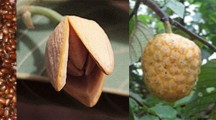Abstract
This study represents a systematic attempt to quantify and compare the degree of familiarity among rural and urban El Salvadorian adolescents with ujushte,Brosimum alicastrum Sw. (Moraceae). To do this, we administered a written questionnaire to 177 students attending school in either San Franciso Menéndez or Apopa, El Salvador. Using a closed-end format, the students provided information about their knowledge of the tree and its fruit, frequency and enjoyment of consumption, method of preparation, and the source of their knowledge. Although most of the rural students knew of the tree and ate its fruit, very few of the urban students indicated familiarity. Statistical hypothesis testing demonstrated that the discrepancy between rural and urban knowledge could not be accounted for by differences in reported socioeconomic status. Grandparents were cited as the most important source of information about ujushte.
Similar content being viewed by others
Literature Cited
Arvigo, R., and M. J. Balick. 1993. Rainforest remedies: One hundred healing herbs of Belize. Lotus Press, Twin Lakes, WI.
Boom, B. M. 1996. Ethnobotany of the Chcobo Indians, Beni, Bolivia, 2nd Edition. The New York Botanical Garden Press, Bronx, NY.
Gomez-Pompa, A., J. S. Flores, and V. Sosa. 1978. The “Pet Kot”: A man-made tropical forest of the Maya. Interciencia 12:10–15.
Johns, T., E. B. Mhoro, and P. Sanaya. 1996. Food plants and masticants of the Batemi of Norongoro District of Tanzania. Economic Botany 50:115–121.
Lentz, D. L., and C. R. Ramírez-Sosa. 2002. Cerén plant resources: Abundance and diversity. Pages 33–42 in P. Sheets, ed., Before the volcano erupted. University of Texas Press, Austin, TX.
Milliken, W., and B. Albert. 1997. The use of medicinal plants by the Yanomami Indians of Brazil. Economic Botany 51:264–278.
Murray, J. 1837. A descriptive account of the Palo Vaca, cow tree of the Caracas, with chemical analysis of the milk and the bark. Effingham Wilson, Royal Exchange, London.
Ortiz, M., Y. Azañón, M. Melgar, and L. Elias. 1995. The corn tree (Brosimum alicastrum): A food for the tropics. Pages 134–146 in A. P. Simopoulos, ed., Plants in human nutrition: World review of nutrition and diabetics. Karger Publishers, Basel, Switzerland.
Pardo-Tejada, E., and C. Sánchez-Muñoz. 1978.Brosimum alicastrum: Recurso silvestre tropical desaprovechado. Instituto de Investigaciones Sobre Recussos Bióticos, A.C. Xelapa, Veracruz, México.
Peters, C. M. 1983. Observations on Maya subsistence and the ecology of a tropical tree. American Antiquity 48: 610–615.
—,and E. Pardo-Tejada. 1982.Brosimum alicastrum (Moraceae) uses and potentials in Mexico. Economic Botany 36:166–175.
Prance, G. T., and J. A. Kallunki, eds. 1984. Ethnobotany in the neotropics: Proceedings, Ethnobotany in the Neotropics Symposium, Society for Economic Botany, 13-14 June 1983, Oxford, OH, The New York Botanical Garden Press, Bronx, NY.
Puleston, D. E. 1982. The role of ramón in Maya subsistence. Pages 353–366 in Kent V. Flannery, ed., Maya subsistence: Studies in memory of Dennis E. Puleston. Academic Press, New York.
Ramírez-Sosa, C. R. 2001. Vegetation of a subtropical pre-montane forest in Central America. Dissertation, The Graduate School of the City University of New York, New York, NY.
—,and S. Yates. 1996. Etnobotanica del ujushte,Brosimum alicastrum, en Tacuba, Ahuachapan, El Salvador: Un estudio piloto. Pankia: Boletin Informativo JBLL, 15:3–4.
Sheets, P. D. 1982. Prehistoric agricultural systems in El Salvador. Pages 99–118 in Kent V. Flannery, ed., Maya subsistence: Studies in memory of Dennis E. Puleston. Academic Press, New York.
Ventocilla, J., H. Herrera, and V. Nŭnes. 1995. Plants and animals in the life of the Kuna. The University of Texas Press, Austin.
Witsberger, D., D. Current, and E. Archer. 1978. Arboles del Parque Dininger. Ministerio de Educación, Dirección de Publicaciones, San Salvador, El Salvador.
Author information
Authors and Affiliations
Corresponding author
Rights and permissions
About this article
Cite this article
Yates, S., Ramírez-Sosa, C.R. Ethnobotanical knowledge ofBrosimum alicastrum (Moraceae) among urban and rural el salvadorian adolescents. Econ Bot 58, 72–77 (2004). https://doi.org/10.1663/0013-0001(2004)058[0072:EKOBAM]2.0.CO;2
Received:
Accepted:
Issue Date:
DOI: https://doi.org/10.1663/0013-0001(2004)058[0072:EKOBAM]2.0.CO;2




